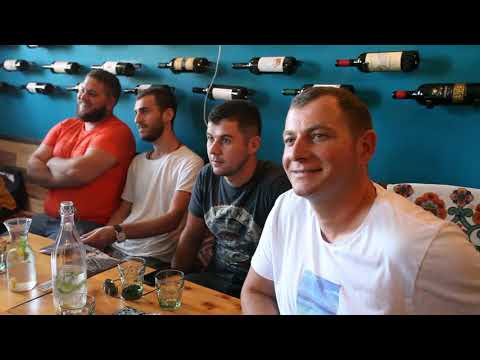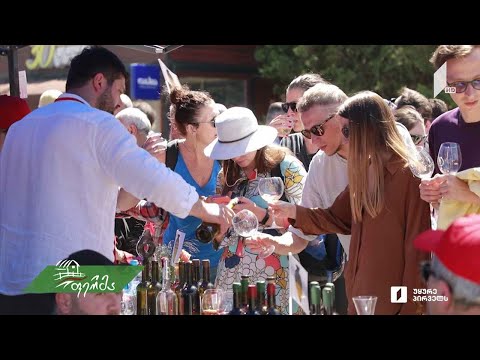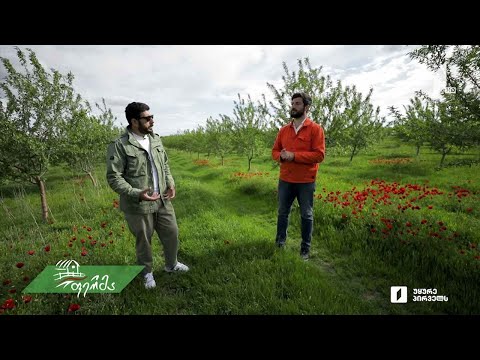ღვინის კლუბის ვიდეო–ჭაშნიკები #1 / Wine Club’s video-tastings Episode #1
ღვინის კლუბის ვიდეო–ჭაშნიკები #1 ქვევრის რქაწითელი Wine Club’s video-tastings Episode #1 Qvevri Rkatsiteli Malkhaz Kharbedia President of Georgian Wine Club George Tevzadze Chairman of Qvevri Foundation Rkatsiteli, Pheasant's Tears, 2011 Rkatsiteli, Lekso Tsikhelishvili’s cellar, 2012 Rkatsiteli, Our Wine, 2013 Terasa restaurant Tbilisi, Tsereteli street #118 (M.K) – Hello, I am Malkhaz Kharbedia. The Georgian Wine Club is starting a new series of video tastings. Today we are presenting our first episode. As part of the program, we will be reviewing and tasting Georgian wines. We will try to cover all styles of Georgian wines starting from whites to red examples. As you might have already guessed, judging from the color of these wines, today we are going to taste Kakhetian qvevri wines. We are now in “Terasa” restaurant, located at Tsereteli street #118. One should mention that there is a variety of great wines to choose from here. It didn’t take us long to decide on the topic of our first video tasting. We chose to start with Rkatsiteli varietal and traditional Kakhetian method of qvevri winemaking. Our guest today is George Tevzadze, the Chairman of Qvevri Foundation and our dear friend, and I will be tasting these three different wines together with George. Before that, however, I’d like to ask George to say a few words about this particular style, which is Kakhetian method of qvevri winemaking and specifically, about Rkatsiteli qvevri wine. (G.T.) – Hello. I’m glad to be part of your innovative series of video wine tastings, which is a wonderful idea. As to qvevri wine and the style itself, this is a unique classic method of winemaking. You have already mentioned the color of these wines, and yes, starting from color to taste and aroma characteristics, these are distinctive wines, they are unique. (M.K.) – Even these three wines differ greatly from each other. (G.T.) – Yes, even these three wines have their own distinct characteristics, however, it all depends on the amount of time during which the wine has been aged, on climate and the conditions, in which the grapes have been grown, also on the region. (M.K.) – and on the winemaking method too. (G.T.) – yes, definitely, it depends on the method as well. Generally speaking, this style is very popular today, however, it should be treated with great care and caution to let it develop in the right direction, so that qvevri wine finds its own place and gets properly introduced not only on Georgian, but also on the international market. So I think it is a great opportunity to go through these wines and analyze them individually. (M.K.) Sure, we may eventually taste various qvevri wines that are produced in different parts of the world as well, but we will, of course, start with our Georgian qvevri wines. As I have already mentioned we are tasting Rkatsiteli today and the first example that we have is Pheasant's Tears Rkatsiteli 2011 made in qvevri. This is one of the first wines, which was included in the New York Times list of wines for under $20. This wine has been well aged for about 3 years, which, I think, is a good amount of time for a qvevri wine to show its charms. What we can say is that this wine, certainly, looks different from the rest of the two. What do you think might be the reason for that? Why does that happen? ვიდეოზე მუშაობდნენ: ნიკოლოზ გრძელიშვილი, მალხაზ ხარბედია, თიკო კოხრეიძე.
Georgian Wine Club-ის სხვა ვიდეოები
 26:08
26:08
ფესტივალის გახსნა - New Wine Festival 2020 27 Dec
 05:29
05:29
ღვინის დუღილი, მეორადი დუღილი, გადაღება - ღვინის ს...
 08:39
08:39
რთველისთვის მზადება - ღვინის სოფელი / Wine Village
 20:28
20:28
8000 მოსავალი - New Wine Festival 2020 - Day 2
 04:33
04:33
ახალი ღვინის ფესტივალი 2015 – საოჯახო მარნების შერ...
 04:08
04:08
ძველი ღვინოები – ახალი ქართული ღვინის სათავეებთან...
 10:15
10:15
კახის ღვინო - New Wine Festival 2020 - Day 2

მსგავსი ვიდეოები

ღვინის ფესტივალი მთაწმინდაზე
პირველი არხი Georgian Public Broadcaster

„ახალი ღვინის ფესტივალი“
პირველი არხი Georgian Public Broadcaster

#გაიგემეტი „ახალი ღვინის ფესტივალი“ მთაწმინდის პარკში
პირველი არხი - ფერმა

„ახალი ღვინის ფესტივალი“
პირველი არხი Georgian Public Broadcaster

#ფერმა როგორ იქმნება ახალი აგროსაქართველოს ისტორია - უდაბნოს...
პირველი არხი - ფერმა

ღვინის ექსპორტი
პირველი არხი Georgian Public Broadcaster

ექსპორტის მაჩვენებლები
პირველი არხი Georgian Public Broadcaster

წინანდალში Radisson Collection-ის ბრენდის სასტუმრო გაიხსნა
პირველი არხი Georgian Public Broadcaster